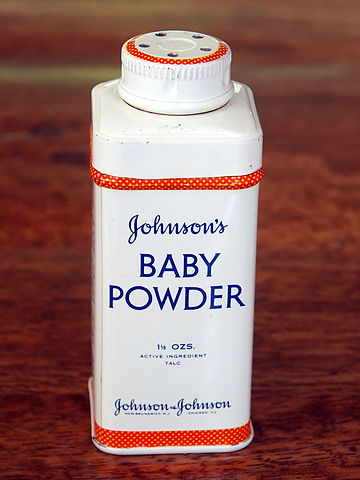
What is talcum powder? It is a mineral found in clay.
When we think of talcum powder, most of us think of the powder we put on a baby’s bottom after they have been changed to prevent nappy rash (diaper rash), or something we put on our nether regions after a tough game of squash. However, it is actually a rock that is mined out of the ground. It is used as baby powder because it is very good at absorbing moisture. Modern nappies (diapers) are very effective at keeping waste water away from the baby, but even the best nappy can’t keep the baby completely dry. And, if there is moisture in the nappy, the dampness can cause nappy rash. The same can apply with adults after sports or showering. Excess sweat can cause rashes and talcum powder can absorb the sweat.
So, what exactly is talcum powder? It is a mineral that is found in the earth and has to be mined. It is usually white, brown, or gray, and it forms flakes. It breaks into thin sheets very easily. It is an extremely soft mineral. The scale of hardness is called the Mohs scale and talc is a 1 on this scale. At the other end is diamond, which is a 10. It is usually mined from an open pit mine. Explosives are used to dig deeper into the mine, but they are used sparingly because talc is so soft that blasting can destroy it. Once the talc is dug up, it can be ground to make powder. The word “talc” comes from Arabic “talq” or possibly Persian “talk” and it was a word used to describe any transparent, translucent, or shiny mineral. “Talcum” comes from Latin, where “um” is the neuter singular ending for a noun.
We mostly know talc from the powder, but that is not its only use. Talc has been around for millennia, and the ancient Egyptians carved scarab beetles and amulets out of the soft talc. The first use of talcum powder on babies was in 1893, when a scientist working for Johnson & Johnson, called Dr. Frederick Kilmer, suggested it. The story goes that someone had band aids on his hand and when he removed them his hands itched. Dr. Kilmer asked for a bottle of Italian scented talcum powder to stop the man’s hands itching, and that gave him the idea to try it on babies. Johnson & Johnson marketed the product, and it was a hit. However, Kilmer didn’t invent talcum powder, he just came up with the idea of using it on babies.
The most common use of talc is actually in the ceramics industry. When talc is added to the ceramics, it lowers the necessary firing temperature, which means kilns don’t have to be so hot. It also improves the thermal shock resistance of the finished product. Talc is also used in paper manufacture. Paper is made of the cellulose fibers from trees and these fibers have microscopic gaps between them. They are too small for us to see, but they make the paper very rough and abrasive. When talc is added, it goes in the gaps and makes the paper much smoother. The talc also helps the paper to absorb and hold ink better. And, as a very white and glossy mineral, it improves the whiteness of the paper. Talc is also used in plastics, drugs, paint, cosmetics, pesticides, rubber, and food. Talc is also an ingredient in chewing gum and is the white powder on sticks of gum that stop them sticking to the wrapper.
Every year, about 8 million tons of talc ore is mined. One quarter of this comes from China, and the next largest talc producers are India, the USA, Finland, and France.
Talc has been in the news recently because a group of women sued Johnson & Johnson because they had ovarian cancer and they believed it had been caused by talcum powder. The news is full of stories that talcum powder causes cancer. Talc can be dangerous if inhaled, but so can many other powders. There is a high incidence of lung cancer among talc miners. There are several other types of cancer that are associated with talc. The problem has arisen because talcum powder can often be contaminated with asbestos. And, as we know, asbestos can cause cancer. How does talc become contaminated with asbestos? They form in similar environments and when you find talc, you often find asbestos. It is difficult to dig the talc up without getting some asbestos with it. !5% of products that use talc test positive for asbestos fibers. Johnson & Johnson are being sued, not because their talc contains asbestos, but because they have known it contains asbestos for over fifty years and they have kept it secret. Talc that is not contaminated with asbestos is probably safe, and it is possible to test the talc for asbestos fibers. However, a lot of industries, such as many cosmetics, don’t require the talc to be tested. And this is what I learned today.
Image By Alf van Beem – Own work, CC0, https://commons.wikimedia.org/w/index.php?curid=30050761
Sources
https://www.nytimes.com/2018/12/14/business/talc-asbestos-powder-facts.html
https://www.cancer.org/cancer/risk-prevention/chemicals/talcum-powder-and-cancer.html
https://en.wikipedia.org/wiki/Talc
https://uwaterloo.ca/earth-sciences-museum/resources/detailed-rocks-and-minerals-articles/talc
https://www.earthmagazine.org/article/mineral-resource-month-talc
https://www.etymonline.com/word/talc
https://www.angeloslaw.com/blog/2016/07/a-history-of-talcum-powder
https://ourstory.jnj.com/johnson%E2%80%99s-baby-powder
https://en.wikipedia.org/wiki/Johnson%27s_Baby
https://www.mesothelioma.com/asbestos-exposure/products/talc-powder
https://www.verywellhealth.com/does-talc-cause-cancer-5088678
